
Naïve art is usually defined as visual art that is created by a person who lacks the formal education and training that a professional artist undergoes. When this aesthetic is emulated by a trained artist, the result is sometimes called primitivism, pseudo-naïve art, or faux naïve art.
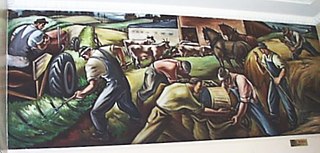
The Northwest School was an American art movement established in the Seattle area. It flourished in the 1930s–40s.
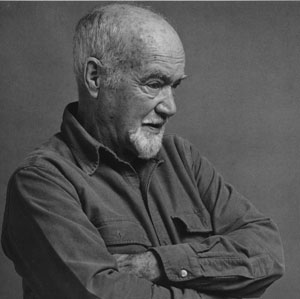
Kenneth Callahan (1905–1986) was an American painter and muralist who served as a catalyst for Northwest artists in the mid-20th century through his own painting, his work as assistant director and curator at the Seattle Art Museum, and his writings about contemporary art. Born in Eastern Washington and largely self-taught as an artist, Callahan was committed to an art that went beyond the merely illustrative. He enrolled at the University of Washington in 1924 but did not stay long. He traveled widely, absorbing influences from the different countries and cultures he experienced. His talent was recognized early; his work was included in the first Whitney Biennial exhibition in 1933 and he went on to a distinguished painting career. Callahan is identified as one of the Northwest Mystics – along with Guy Anderson, Morris Graves, and Mark Tobey, who shared a muted palette and strong interest in Asian aesthetics.
Philip Martin Pearlstein was an American painter best known for Modernist Realist nudes. Cited by critics as the preeminent figure painter of the 1960s to 2000s, he led a revival in realist art.

Gage Academy of Art is a fine art school located in Seattle, Washington, specializing in drawing, painting and sculpting. The core of its programming is traditional observational training, with an emphasis on the foundational skills of figure drawing and painting. Other classes include perspective, watercolor, still-life drawing and painting, cast drawing, egg tempera, design concepts, color theory and encaustic techniques.
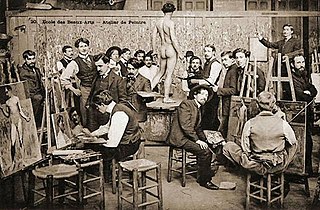
An atelier is the private workshop or studio of a professional artist in the fine or decorative arts or an architect, where a principal master and a number of assistants, students, and apprentices can work together producing fine art or visual art released under the master's name or supervision.

Classical Realism is an artistic movement in the late-20th and early 21st century in which drawing and painting place a high value upon skill and beauty, combining elements of 19th-century neoclassicism and realism.

William Lee Cumming was a noted 20th-century American artist, often associated with the Northwest School. A controversial figure - he was a hardcore Stalinist for a long period, was married seven times, and was generally outspoken and opinionated - he eventually came to be respected as an important innovator and highly distinctive stylist in modern art, particularly in the Pacific Northwest.
James W. Washington Jr. was an American painter and sculptor who grew into prominence in the Seattle art community.
Tom Loepp is an American figurative, portrait and landscape painter.
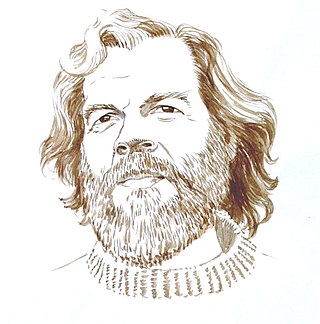
Bill Martin was a realist and visionary artist. "Bill Martin's images possess an inexplicable compelling power," wrote Walter Hopps, the Smithsonian Institution's Curator of the 20th Century American Art Collection.

Paul Havas was an American painter. Havas is known for his landscape paintings.
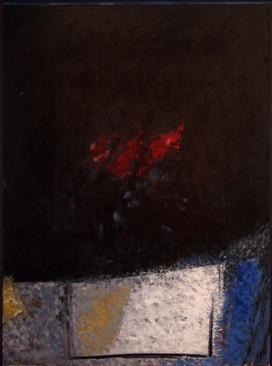
William Ivey was an American abstract expressionist painter, sometimes associated with the Northwest School of artists. After stints in the US Army and studying art in California, he spent most of his career in Seattle, Washington. Seattle Times critic Deloris Tarzan Ament described him as "the Dean of Northwest Painters".

John Takehisa Matsudaira was an American painter active mainly in Seattle, Washington from the 1940s through the 1970s. He was involved in the Pacific Northwest's vibrant Asian-American art community, and is sometimes associated with the 'Northwest School' of artists.

Jet Kiss is a 2015 sculpture by American artist Mike Ross, installed at the Capitol Hill light rail station in Seattle, Washington. The 90-foot-long (27 m) sculpture consists of two decommissioned A-4 Skyhawk fighter jets that were sliced and arranged nose-to-nose; the piece is suspended above the station's platform level.

Helen O'Toole is an Irish-born painter based in the United States, who is known for abstract paintings suggestive of landscape. She has exhibited throughout Ireland and the United States, in Singapore, and at venues including the San Francisco Museum of Modern Art, Portland Art Museum, Chicago Cultural Center, Tacoma Art Museum, and Institute of Contemporary Arts Singapore. Her work has been featured in the journals Artforum, Arts Magazine, New Art Examiner, and Zyzzyva, as well as the Chicago Tribune,The Irish Times, Seattle Post-Intelligencer, and National Public Radio. Art writers frequently discuss the interplay in her work between abstraction, the evocation of otherworldly light, land and space, and a commitment to investigating meaning through a painting process akin to the processes of cultivation and excavation. Artforum critic James Yood wrote, "echoing the often inchoate quality of nature, her paint surges toward mystery and hints at a kind of chiaroscuro of the spirit"; curator Bonnie Laing-Malcomson suggests her "richly colored monumental paintings evoke the moody landscape of her rural Irish homeland, summoning the force of J. M. W. Turner and Mark Rothko." She has been recognized with a Guggenheim Fellowship in Fine Arts, a Contemporary Northwest Art Award, and a Pollock-Krasner Foundation Award (2013), among other awards. O'Toole lives in Seattle, Washington and is Professor of Art and Chair of the Painting and Drawing Program at the University of Washington.
Mary Ann Peters (1949) is an American. Her large scale paintings and installations deal with the themes of immigration and the refugee crisis. She is a founder of COCA.
C. Davida Ingram is a conceptual artist specializing in gender, race and social practice. Her art explores desire, space, time and memory, while questioning 21st century black female subjectivity. She is also a public speaker and civic leader. She received the 2014 Stranger Genius Award in Visual Arts. In 2016 she was a Kennedy Center Citizen Art Fellow, a finalist for the 2016 Neddy Arts Award, and 2018 Jacob Lawrence Fellow. Ingram, along with Prometheus Brown of Blue Scholars, and Tony-nominated choreographer and director, Donald Byrd at the 2016 Crosscut Arts Salon: The Color of Race. In 2017 she was featured in Seattle Magazine's Most Influential Seattleites of 2017. In the same year she received the Mona Marita Dingus Award for Innovative Media.
Ruth Cleland is a New Zealand artist, based in Auckland. Her works are held in the collection of Auckland Art Gallery Toi o Tāmaki. Cleland is known for her photo-realist paintings and pencil drawings of suburban landscapes, and her abstract grid works. Cleland lives in Auckland with her husband and fellow photo-realistic artist Gary McMillan.
Michael Charles Spafford was an American artist known for his archetypal, figurative oil paintings drawn from Classical mythology. Spafford taught painting at the University of Washington, Seattle until his retirement in 1994.













